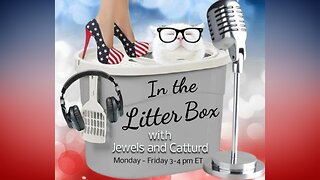Premium Only Content

The Basics of Gold: Protecting Your Wealth and Spending Power | The Gold Standard 2323
https://www.midasgoldgroup.com/
Welcome to another episode of The Gold Standard, where we delve into the fascinating world of precious metals and their role in safeguarding your financial future. In this highly informative installment, your esteemed hostess, Jennifer Horn, is joined by Ken Russo.
2021 marked the 50th anniversary of President Nixon taking us off the gold standard. Immediately our dollars were no longer convertible into precious metal bullion. Nixon’s action untethered the currency, which is now measurable only by comparing it to currencies from other countries. Ironically, there were still restrictions on private ownership of gold coins and bars at this time. Not until President Ford signed a bill in 1974 could US citizens freely buy and trade bullion for the first time since President Roosevelt’s confiscation of gold in 1933.
You don’t have to do much searching to find examples of gold being a reliable store of value. At the time FDR issued Executive Order 6102 in 1933, an ounce of gold was redeemed by the Fed for $20.67, which, in today’s value, is equivalent to $482.35. You could buy an ounce of gold in 1932 for about $482 in today’s dollars. Today, the average spot price of gold hovers over $1,900, while the value of the dollar has lost 92 percent of its purchasing power since 1933. Gold bullion is one of the most liquid assets in the world, with a daily trading volume of more than $145 billion.
Not too surprisingly, taking the country off the gold standard introduced us to an era of runaway debt. Before 1971, there was a natural limit to printing money because the amount had to reconcile with the amount of gold sitting in the nation’s reserves, but that’s no longer the case. With no hard assets to back the currency, the government has adopted an addicted-to-debt mindset. The federal debt is at an astronomical $31.5 trillion (rounded off) and counting. You can’t think of the number without your eyes watering up, wondering how it will ever be paid off. The fact is, it’s never going to be paid off. The debt will keep growing, and the government will keep printing more cash to pay its bills.
Anytime the government makes promises to its citizens without knowing how they will pay for it, which happens a lot, it is an unfunded liability. Examples of these include Social Security, promised to us by FDR in 1935, and Medicare, established by LBJ in 1965. Unfunded liabilities continue to grow; they outpace the US economy many times over. The federal government faces an unsustainable fiscal future.
The escalating debt levels and poor leadership present a challenging landscape for the US economy and for each of its citizens. Jennifer and Ken shed light on the implications of this double whammy and how it impacts our attempts to save and preserve buying power. Gain valuable insights into the potential consequences and explore why owning physical gold is critical. As governments and currencies come and go, gold remains a steadfast symbol of financial stability and a tangible representation of wealth.
The definition of money has three parts. It must be a medium of exchange; be a store of value and be a unit of account. Gold has all three, and that’s why it has been money since ancient times. Gold and silver have been utilized as forms of money throughout civilization, spanning numerous cultures and epochs. Societies have recognized these precious metals for their inherent qualities. Gold’s scarcity, durability, divisibility, and intrinsic value made it ideal for facilitating trade and economic transactions. Egyptians, Greeks, and Romans, the empires of the Middle Ages and beyond, have used gold and silver coins as trusted forms of trade. Even today, gold and silver retain their allure. Regarded as safe-haven assets, they offer individuals a tangible store of wealth in times of economic uncertainty.
Fractional reserve banking has long been debated and criticized, with concerns about its inherent instability. The system operates on the principle that banks can hold a fraction of their deposit liabilities as reserves while lending out most funds. However, this practice is a pyramid-like structure with multiple layers of debt built upon a limited base of reserves. Fractional banking is inherently unstable. We have seen many examples of excessive risk-taking, speculative behavior, and abuses of power.
The Gold Standard provides valuable insights into the importance of incorporating precious metals into your financial strategy. You’ll learn pathways toward safeguarding wealth and preserving purchasing power. For more enlightening discussions on the state of the economy and how precious metals can help protect your buying power, please subscribe to our channel.
__________________________________________________________________________________________________
Gold IRA: https://www.midasgoldgroup.com/gold-ira/
Guide to Owning Bullion & Coins: https://www.midasgoldgroup.com/bullion-guide/
-
 25:06
25:06
Midas Gold Group
3 months agoThe Collapse of FERN (Federal Reserve Note) | The Gold Standard 2428
45 -
 47:12
47:12
Candace Show Podcast
2 hours agoBeyoncé Was Paid $10 Million For A 3 Minute Endorsement?! | Candace Ep 103
46.8K102 -
 47:41
47:41
Kimberly Guilfoyle
3 hours agoShock to the Swamp: No More Business as Usual, Interview with Darren Beattie | Ep. 174
46.8K8 -
 1:04:06
1:04:06
In The Litter Box w/ Jewels & Catturd
22 hours agoSUCK IT UP! | In the Litter Box w/ Jewels & Catturd – Ep. 691 – 11/14/2024
67.2K20 -
 10:13
10:13
Mike Tyson
4 hours ago $6.14 earnedThe Will Determines the Skill | BEHIND THE MIKE #007
36.1K8 -
 DVR
DVR
Savanah Hernandez
1 hour agoHUGE SHAKE UP: Deep State fearful as Trump appointees shock the nation
20.5K11 -
 1:02:33
1:02:33
The Officer Tatum
2 hours agoLIVE: Liberals MELT DOWN Over Trump and Biden Meeting, Al Sharpton EXPOSED
37.9K19 -
 6:41
6:41
Film Threat
2 hours agoSYDNEY SWEENEY SAYS FEMINISM IS FAKE | Film Threat News
13.8K6 -
 30:53
30:53
Chef Donny
3 hours agoWhipping Up The Best Thanksgiving Mashed Potatoes with Rudy Junda | Chef Donny @Pepsi Live Stream
29.4K6 -
 59:15
59:15
Matt Kim
15 hours agoQuestions You’re Not Allowed to Ask After Trump’s Win | Matt Kim #124
28K6